It’s January. It’s dark. It’s cold. The nesting boxes are empty.
The 12 Gems laid only 5 eggs this week. This time of year I certainly don’t expect a full basket, but a few more eggs would be nice. I’m not going to use light to encourage laying, but I do have another way to boost production. At least, I hope so! This trick is one that I’ve read about in many of my vintage poultry books and magazines: they all advocate feeding alfalfa in the winter when green forage isn’t readily available.
Alfalfa, also called alfalfa hay, is not the same as hay. Hay is made by cutting and drying grasses. Timothy and grass hay are mostly roughage and not something to feed to hens (although they might like to scratch through it and find a seed or two.) Alfalfa grows in a field and on stems like hay, but the plant is a legume. It’s high in protein, and its fiber is highly digestible. Alfalfa contains calcium, nitrogen and other vitamins and nutrients. According to my sources, alfalfa is supposed to boost the hen’s off-season diet and encourage laying. Although feeding greens, like cabbage, is a good addition to the winter diet, it doesn’t have the protein that hens need. Feeding meal worms and sunflower seeds is not the answer, as they can be too concentrated and do more harm than good. However, alfalfa supplies protein without the danger of overconsumption, and delivers nutrients in a form and amount that is perfectly suited to a hen’s metabolism. (By the way, coarse yellow straw is not a foodstuff, not even for cows. Straw is made up of the stems leftover from the wheat or barley harvest and is suitable only for bedding for large animals.)
I’ve never bought alfalfa, but knew that most grain stores would have it. The first feedstore that I went to had bales of it for sale that weighed 125 pounds each and were the size of small sofas. I didn’t buy one. But, Erikson Grain had a more manageable bag.
The alfalfa looked coarse, but a close inspection showed much dried green leafy matter.
I shook the hay over the ground in the outside run. The hens, who had been clucking loudly at me, all went quiet and immediately set to eating.
Even Agatha (she’s the Speckled Sussex on the far right) stopped being fascinated with my camera and put her head down to eat.
If I had a farm a hundred years ago, I would have had a chaff cutter which would have chopped the coarse stems into edible bits. Perhaps I’ll find that tool at a flea market, but for now they are getting all of it, the easy to eat leaves and the long stalks. The general advice is not to feed tough stems to hens. There’s a chance of crop impaction. If your hens are hungry, or if they’re terribly bored, they might try to eat the stalks. But, my hens have free-choice pellets. They have a compost pile to scratch in. They ignore inedible stems. Because I have goat and the rabbit, they have access to hay, which is much tougher to digest than the alfalfa. I’ve never had a problem. That’s not to say that I don’t discount the issue. I’m careful to not give them whole scallion stalks, which they might try to eat. I don’t feed green cut grass, as I’m sure they’d gobble it down and get blockages. But, my girls are savvy enough to know to eat the leafy greens and ignore the stalks. So, for now, without the chaff-cutting tool to make all of the alfalfa plant useful, there will be some waste and they’ll just eat the leaves. Which might not be so bad, since that’s the most nutritious part.
I think that it will take a week before I know if the alfalfa encourages laying, but if it doesn’t this won’t be for naught. I do think that alfalfa will replenish their mineral and protein stores lost after a year of laying and molting. I expect my hens to primed and ready for spring egg laying by the end of next month.
The goats heard me shaking out the alfalfa. They bleated and they pleaded but I didn’t give them any. Alfalfa, as good as it is for hens, is not good for my wethers, as calcium can cause urinary calculi to form. The goats are fed a second cutting grass hay. It’s leafy and green, and just right for the boys.
I’ll let you know if there’s an uptick in the egg count. In the meanwhile, the hens are delighted about this feed trial. They’ve already deemed it delicious.
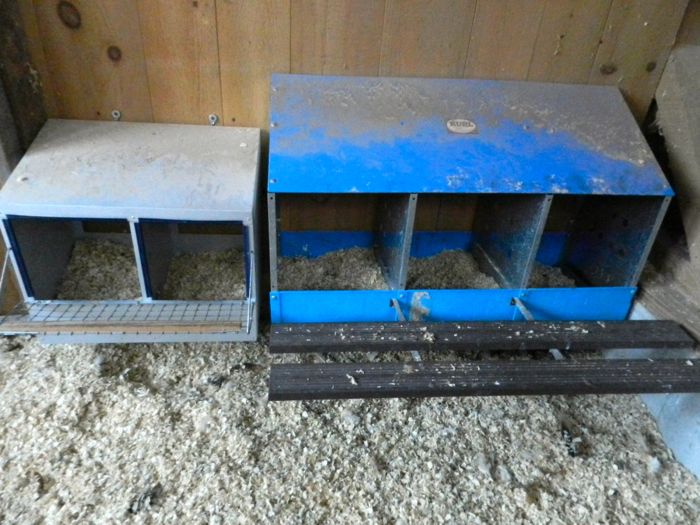
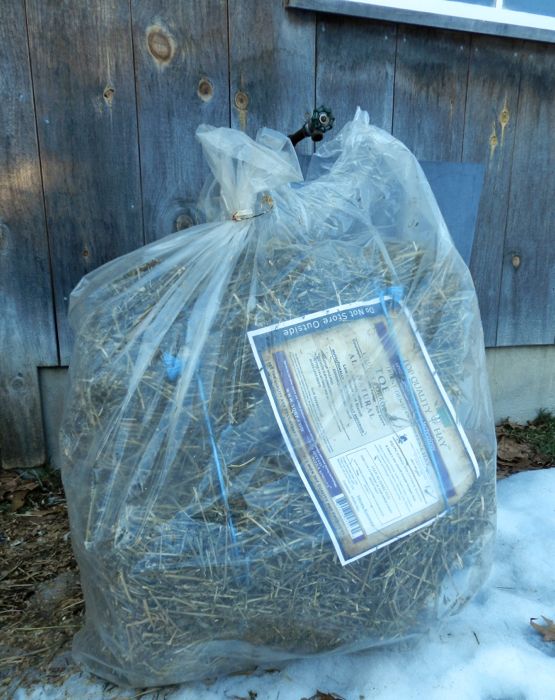

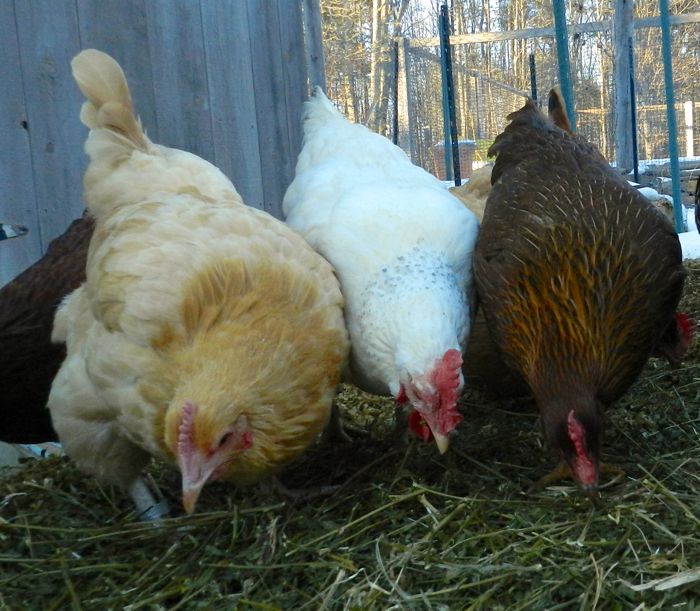
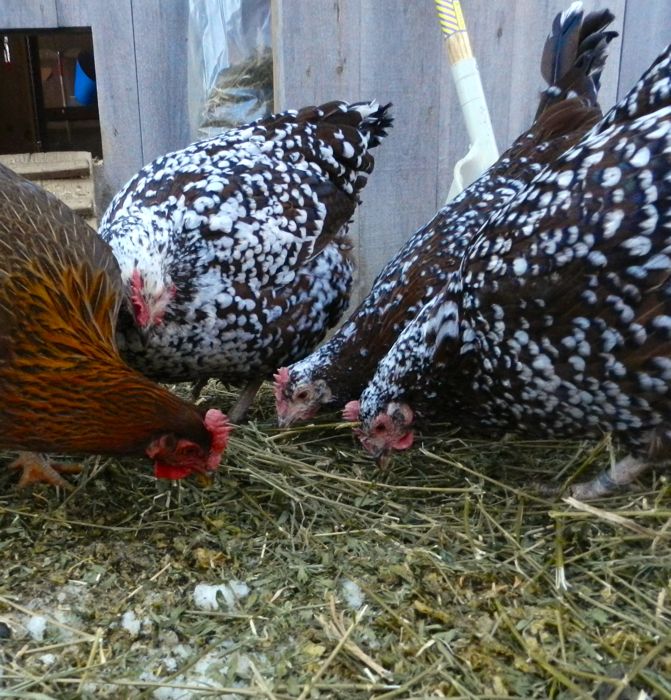
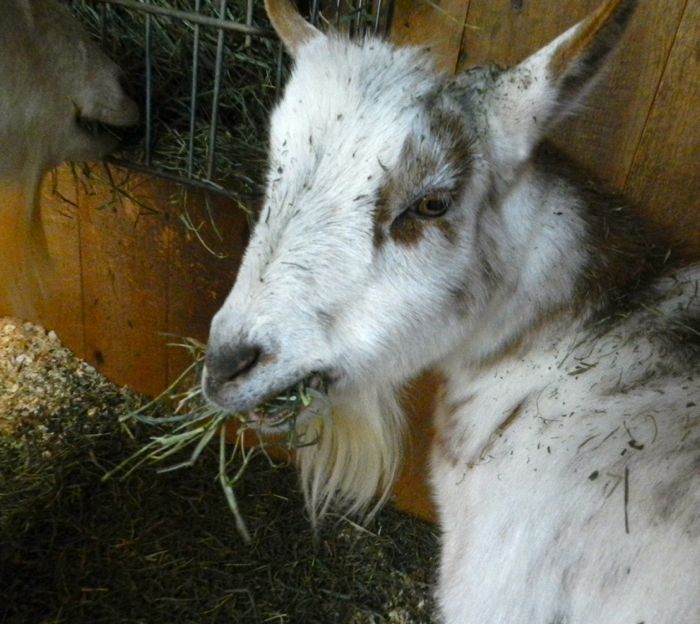

I have been wondering about feeding alfalfa to my hens. I didn’t know if there was any risk of the chickens swallowing the long pieces and getting them stuck in their crops, as can happen if they are given long pieces of cut grass.
Oh, what a timely post. I’ve been really curios to try alfalfa. But concerned because I have a hen who’s ate straw and got sour crop. Now I just need to hunt around to see if I can find something smaller than a whole bale which is way too big for me too.
Terry is it okay to feed the alfalfa in whole pieces or does it have to be chopped up first? I’ve read that feeding hay can cause an impacted crop. Also will you give the hens alfalfa every day or just once in a while?
Mine actually like and eat the alfalfa pellets, but Erikson’s sells only 40 lb bags – but the extra is a good soil amendment too…
Hi Terry,
I’m designing a new coop for the spring. Ours is way too small for the flock of 7 that we have. I’m curious, how many nesting boxes are appropriate? 0.5 per hen? I realize that no matter how many I have, only 1 or 2 will the the “desirable” ones where the cool/trendy hens lay.
Thanks,
Ed
A general rule is one box per 5 hens, but that doesn’t work for small flocks. I’d go with three for seven hens. You could get by with 2, but if you have a broody the other box will be crowded. BTW, follow me on Pinterest. I have a board of coops that I like, annotated with my comments.
Thank you Flock Mistress, Debbie and Sasha, for your comments. I should have explained the coarse stem issue better. You are right to worry about impaction with tough, long food items. That’s why I wish that I had a chaff cutter – to mince the stems until small. But, I don’t. The alfalfa stems aren’t going to appeal to my hens – fat chickens who have plenty of good food in front of them at all time. The stems are wider and coarser than hay. I watched for awhile, and not a single hen even pecked at the stems. All they ate were the leaves and short pieces, so it’s wasteful but not dangerous. Alfalfa pellets are certainly an option. However, I like to feed things that take a bit of work for the hens to get. Keeps them busy, out of trouble, and they don’t gorge themselves.
As far as hay goes, because of the rabbit and the goats, my hens have access to it, but it hasn’t been a problem, again, because they have much more appealing food in front of them. No fools, my girls! I don’t feed grass clippings, as they do find them yummy, and they will get impacted crops from eating too much.
My 30 chickens and I live in California about 25 miles east of San Francisco. Our winters are ‘green’ as this is the time of the year the grasses grow because of the rains. Needless to say, the chickens do not allow grass to grow in their yard. I grow my own greens for them (collards, lettuce, spinach, chard, kale) but I also suppement the chickens’ diet with alfalfa cubes that I soak overnight in water. I buy 40 pound bags from the feed store. My ladies love the alfalfa but from four year’s experience I can tell you this will not increase egg production. In the winter my ladies lay at most five to seven eggs. The hen’s ages range from six months to four years and I have a variety of supposedly great layers including a white leghorn, several Rhode Island Reds, Ameraucas, Speckled Sussex, Plymouth Rocks, etc. The last time I bought alfalfa cubes the clerk mistakenly gave me a bag of alfalfa pellets. My friend says her chickens love the moistened pellets but mine will not touch the stuff. As another reader pointed out, alfalfa is great for amending garden soil. It can revive a dying compost pile overnight! I think these pellets will ‘feed’ the compost pile :(
Thank you for your first-hand experience. It’ll be interesting to see what happens here! There are some differences between your flock and mine. My girls don’t have access to any forage other than this alfalfa, so they might be getting a more concentrated dose than yours. Also, the leaves are the most nutritious part, and they’re not eating the stems (which your hens are, as they’re ground into the cubes.) Some cubes are mixed with plants other than alfalfa, and so even less nutritious. In any event, I’ll be raking up what they don’t eat and into the compost it will go, so we’ll all have wonderful soil this spring :)
Terry- I had the same concern as Sasha….I have read multiple blogs that have talked about compacted crops from hens eating the stalky part of straw…is that not a problem with the alfalfa?
nevermind, just saw your comment! thanks!
Please let us know how it works. I do mix some sunflower seeds and millet and flax into the feed. Why is the sunflower seed bad for them?
Sunflower seeds are fine in moderation. My old girls get a little each day. But, they are high in fat and protein and can cause problems when tossed by the fistfuls like some people do. I bet that your giving them the right amount. One thing though, mixing treats into pellets causes waste – the hens toss out what they don’t want in order to get to the good stuff. You’ll find a lot of pellets tossed on the ground and wasted that way. I’d keep the pellets separate from the treats.
Hey Terry!
Great blogpost as usual. I do have one question, though. The alfalfa looks rather dry in the pictures, so should it be soaked in warm water beforehand to reconstitute it?
Thanks,
Kelly
Bought in hay form it does not have to be wet (I wouldn’t, as hay tends to mold) but if purchased in the cubes it helps to dampen it. See Pam’s comment on how she does it. Pam is a real farmer!
For the past year I have used alfalfa as the bedding in my Coop. The reason for this is we have a alfalfa field behind our house. Since our only “livestock” are my chickens, we let a rancher friend hay it, in exchange for one large round bale. This is too big for me to use, so we trade it with the neighbors, who have a dairy, for several small cubes. Works great. Haven’t had any problem with the chickens. This year however, because of drought, the field wasn’t even worth cutting. I have been using wood chips instead. I miss having the alfalfa. I’m going to have to buy some, if I can find it. Bummer.
It’s nearly impossible to get alfalfa hay here. The horse people buy an entire field of it before it is harvested. I did get a bale once and kept it in the shed. I gave the hens one “flake” at a time. This winter I bought 2 large timothy bales for a wind break for them. Fortunately they don’t eat it, but one hen will stand by it, pull out pieces and throw them over her shoulder. She does that in the nest box as well. We are figuring out how to grow our own alfalfa next year. Now I just grow alfalfa fodder for the hens.
I’ve fed alfalfa mash year round for years. For 18 hens I use a cup of the organic pellets and less than a quart of water or cheese whey if I have some. I let it soak overnight, by the wood stove in winter or just on the hearth the rest of the year, in a large flat Fortex tub. Some days they really go for it, other days not touch it. It helps keep the egg yolks orange (beta carotene) and adds some proteins.
Wow! So much to know. I grew up watching old movies and cartoons where goats ate tin cans and people just sprinkled a bunch of something out for chickens. They wouldn’t have lasted long!
Hiya Terry, Mine love alfalfa tea! I boil up a giant pot of alfalfa and water (I do this outside as it’s a bit stinky!) let it cool and then put it in their fount. They go crazy for it!
Interesting! Where did you get that idea? Have never heard of it. Too much work for me :) BUT I wonder if it would be a good tonic for an ailing hen?
My girls LOVE alfalfa..I rake up the left over bits that fall through the pallets after feeding the horses. They go wild when I bring a bucket of it in!
This is off the alfalfa topic, but I was wondering if anyone has ever tried using a retrofitted plastic playhouse as a coop? Predator proofing would have to be done, but it seems like it would hold up well in my humid climate and would be easy to disinfect as needed.
I am inching closer to my own chickens!
Thanks.
Nevermind! Found lots of examples.